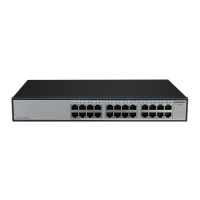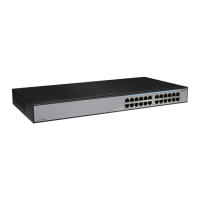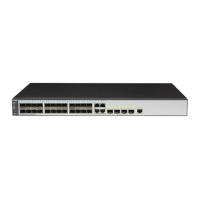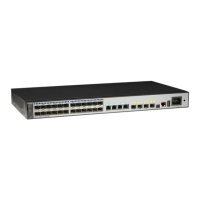Similar to a BGP community filter, a BGP extcommunity filter is used to filter private
network routes.
Perform the following steps on a BGP switch:
1. Run:
system-view
The system view is displayed.
2. Perform either of the following operations as required to configure an extcommunity
filter.
– To configure a basic extcommunity filter, run the ip extcommunity-filter { basic-
extcomm-filter-num | basic basic-extcomm-filter-name } { deny | permit } { rt
{ as-number:nn | ipv4-address:nn } } &<1-16> command.
– To configure an advanced extcommunity filter, run the ip extcommunity-filter
{ adv-extcomm-filter-num | advanced adv-extcomm-filter-name } { deny |
permit } regular-expression command.
Multiple entries can be defined in an extcommunity filter. The relationship between
the entries is "OR". This means that if a route matches one of the rules, the route
matches the filter.
l Configure a route-policy.
A route-policy is used to match routes or route attributes, and to change route attributes
when specific conditions are met. As the preceding filters can be used as matching
conditions of a route-policy, the route-policy is powerful in functions and can be used
flexibly.
Perform the following steps on a BGP switch:
1. Run:
system-view
The system view is displayed.
2. Run:
route-policy route-policy-name { permit | deny } node node
A node is configured for a route-policy, and the view of the route-policy is displayed.
A route-policy consists of multiple nodes. For example, the route-policy route-
policy-example permit node 10 command specifies node 10 and the route-policy
route-policy-example deny node 20 command specifies node 20. The two nodes
belong to the route-policy specified by route-policy-example. The relationship
between the nodes of a route-policy is "OR". The details are as follows:
– If a route matches one node, the route matches the route-policy and will not be
matched with the next node. For example, there are two nodes defined using the
route-policy route-policy-example permit node 10 and route-policy route-
policy-example deny node 20 commands. If a route matches the node defined
using the route-policy route-policy-example permit node 10 command, the route
will not be matched with the node defined using the route-policy route-policy-
example deny node 20 command.
– If a route does not match any node, the route fails to match the route-policy.
When a route-policy is used to filter a route, the route is first matched with the node
with the smallest node value. For example, if two nodes are configured using the
S6700 Series Ethernet Switches
Configuration Guide - IP Routing 7 BGP Configuration
Issue 01 (2012-03-15) Huawei Proprietary and Confidential
Copyright © Huawei Technologies Co., Ltd.
399

